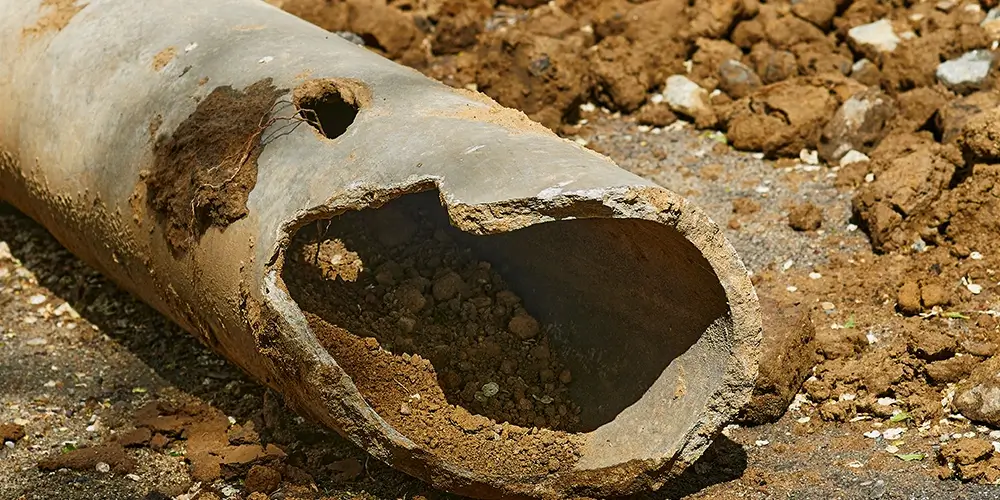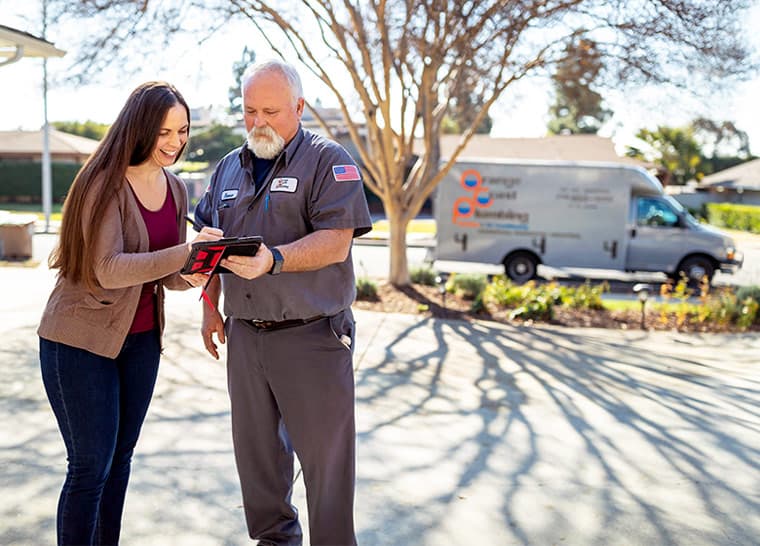Sewer lines are the dump trucks of your plumbing system. They haul away tons of unwanted, uh, stuff, load by load.
They’re under less pressure than water pipes. Their contents are slower moving.
Why, then, would they ever collapse? Yet they do with surprising frequency, and it’s always unpleasant when it happens.
Signs of a Collapsed Sewer Line
1. Toilet Backup
If your toilet won’t flush, flushes slowly, or backs up when you try to use other fixtures, chances are there’s a blockage or break somewhere in the pipes.
2. Gurgling Sounds
Sewer lines often produce odd noises when they’re clogged or collapsed. “Complaining” pipes are telling you something’s wrong.
3. Universally Malfunctioning or Slow Drains
All drains — bathroom sink drains, bathtub drains, etc. — will be slow or backed up if there’s a blockage or break in the main sewer line from your house to the municipal sewer pipe.
4. Standing Water
If you notice wet spots, standing water in your yard, or any puddles unrelated to rain or sprinklers, you may have a broken water or sewer line.
5. Foul Odors
Sewer lines can emit strange odors if they’re blocked or collapsed. Follow your nose and investigate the source if you smell anything out of the ordinary coming from your drains or backyard.
6. Tree Root Infiltration
Trees love sewer pipes. Boy, do they ever, because that sewage contains water and nutrients essential to their growth. Tree roots work their way into joints and cracks in the sewer line; unfortunately, they’ll cause blockages and breaks.
7. Sinkholes in Your Yard
A sinkhole in your backyard or driveway is a telltale sign of a collapsed sewer line. If you ever see one, contact a plumber immediately!
8. Mold and Mildew Growth
Water seeping from a damaged sewer line can lead to mold and mildew growth. Fungal infestations are often due to problems with your plumbing system, including a collapsed sewer line or a dreaded slab leak.
What to Do If You Suspect a Sewer Line Collapse
Can there be other signs of a sewer line collapse? Yes, of course, but we’ve listed the most common ones here. You’ll probably notice at least one of the above distress signals if your sewer pipe has gone rogue.
So then, what should you do? A plunger, snake, or hydro jet won’t clear a collapsed sewer line. Repair is a job for professionals. Don’t postpone the call — sewage backups can cause incredible damage, including foundation damage and toxic mold growth.
Depending on the location of the break and the general condition of your sewage pipe, the plumber will:
- Replace a section of your sewer line;
- Dig up and replace the entire sewer line;
- Use a method like pipe busting for a trenchless repair;
- Reline the sewer pipe with epoxy resin (cured-in-place piping).
Each method has its pros and cons and related costs, which the plumber should discuss in detail.
Sadly, there’s never a cheap repair option for pipe collapse. And if your homeowner’s insurance doesn’t cover the repair, you may have to finance it.
This may lead you to wonder what caused the collapse in the first place. Is there anything you could have done to prevent it?
Common Causes of Sewer Line Collapse
1. Pipe Age & Corrosion
Older pipes made from clay, cast iron, and galvanized steel are prone to corrosion. PVC drain pipes have an expected life of 25-40 years. Soil and water conditions can accelerate the deterioration or aging process.
2. Tree Root Infiltration
We’ve already covered this one — tree roots can work their way into sewer pipes and eventually cause breakage or collapse.
3. Ground Movement & Settling Soil
Soil shifts, landslides, and other geological movements are hard on pipes. So is gradual ground settling — especially if your pipes weren’t laid correctly! Orange County’s clay soils are notorious for shifting. Vibrations from heavy equipment or passing trains can also damage pipes.
4. Clogs & Blockages
Flushing anything besides human waste and toilet paper is a sure way to cause problems — tampons and flushable wipes come to mind. Clogs created by foreign objects or sanitary products are among the most common causes of sewer line collapse. Grease buildup is another culprit — it coats the inside walls of your sewer pipe and eventually restricts flow through it.
5. Foundation Leaks & Subsidence
Leaking foundations can leach water into the ground, softening the soil and making it shift. Subsidence or sinking of the home’s foundation can damage sewer pipes.
6. Extreme Weather & Natural Catastrophes
Heavy rains, floods, or a moderate earthquake could be enough to break your sewage line — especially if it was already weakened by age or corrosion.
7. Poor Installation & Defective Pipes
Pipes laid at wrong angles or with improperly connected joints and fixtures are more likely to break. Cheap piping gives way more readily than quality materials. Defective lines with weak spots are liable to crack under pressure from sewage water or shifting ground.
How Can You Prevent Sewer Line Collapse?
The best defense against a collapsed sewer line is proactive maintenance.
Have your sewer pipe inspected and cleaned by a licensed plumber every 1-2 years or if you suspect a problem. An inspection should include camera work to check for breaks, blockages, or root infiltration.
Also:
- Don’t flush anything other than human waste and toilet paper.
- Limit the use of chemical drain cleaners; they don’t always solve the problem, and they can corrode your pipes.
- Use root barriers or professional root removal to keep tree roots away from your sewer lines. Please don’t dump chemicals down your sewer lines or onto your yard!
- Never pour grease down your sink or bathtub drains!
Methods of Repair: Pipe Bursting vs. Pipe Lining
Modern trenchless technology (pipe bursting or cured-in-place piping) is much less invasive than excavation. Plumbers dig up only the beginning and end points of the repair and not the length of the line.
The two primary trenchless methods for sewer lines are pipe bursting and cured-in-place piping (CIPP).
Pipe bursting involves pulling a wedge through the old pipe to burst it and then drawing a new line through in its place. Pipe bursting works best for brittle or badly corroded older pipes made from clay, cast iron, or PVC.
CIPP, on the other hand, lines the old pipe with a thick and durable epoxy resin, resulting in a pipe that’s often stronger than the original. CIPP is ideal for PVC pipes damaged by corrosion or tree root infiltration but more or less intact.
Which method of repair is best for your broken sewer line? Your plumber should provide you with an honest assessment and help you make a decision based on the condition of your sewer line, the soil around your home, and your budget.
Or, if you live in Orange County, CA, call us at Orange Coast Plumbing for a free consultation.


